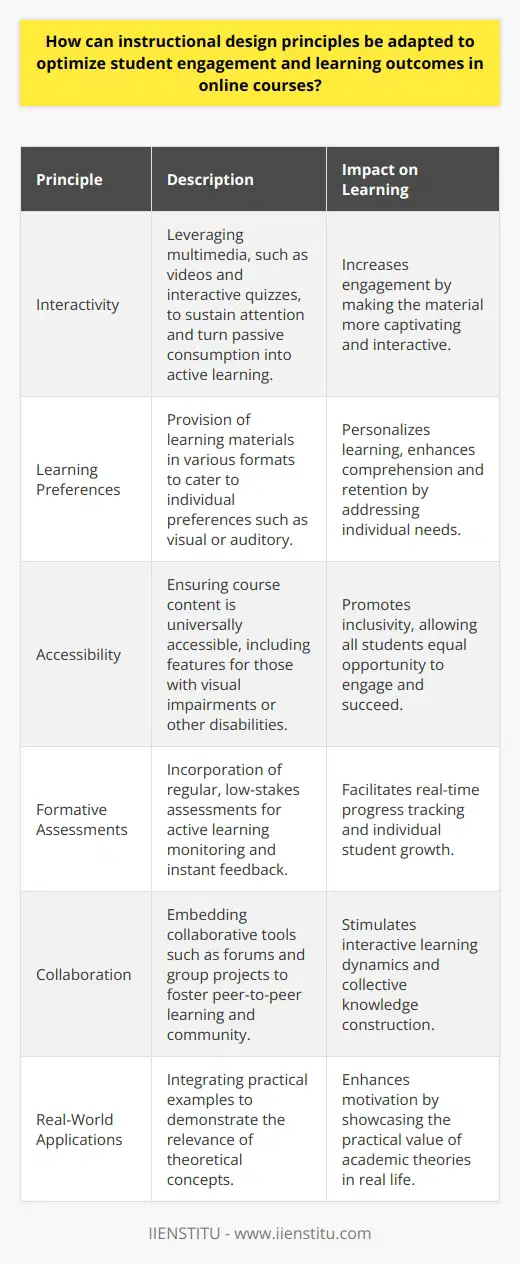
The online course is a relatively new phenomenon. Some significant advantages to studying online may appeal to you. You can learn at any time of the day, from anywhere. The online lecturer will probably have prepared online lecture materials for you already.
Second, many courses are built around online modules with downloadable lectures and other materials.
Third, many online courses offer actual discussion boards where students can get together and not only discuss but debate what they have been studying for the past week or so. These online courses are more interactive than regular online learning seminars, which may sometimes be found lacking in this respect.
Finally, some online courses outsource their marking to third-party agencies who will return marked coursework within 48 hours; this degree of efficiency usually is only found online.
What's the Important Thing about Choosing Online Course?
Many online courses come with online support forums specifically designed to help online students out if they are stuck or for the online student who needs some extra support to complete their online course.
This is a great way to ensure that your online experience is as rewarding as possible. In addition, this kind of support will encourage you to feel more involved in the online course and make you less likely to drop out of it before completion. Of course, it would be good if all online courses offered this level of interaction, but not everyone has the budget.
Some online courses may also allow you to access recorded lectures after they have taken place to go back over them at your leisure. It is excellent for those people who miss online courses because they are not online at that time or would just like to review online lecture materials.
Some online courses may also allow you to access recorded lectures after they have taken place so that you can go back over them at your leisure, which is excellent for those people who miss online lessons because they are not online at that time or would just like to review online lecture materials.
Suppose this is the case with your online course. In that case, it might be wise to make sure that there is an online assignment submission system in place, too, if you do not wish other students to see work before it has been assessed and graded.
Many online courses will provide their students with an online tutor should the need arise; again, this level of support makes it far less likely that online students will drop out of online courses before completion.
Some online courses provide online tutors who answer questions and mark online coursework online, which is a great way to encourage online students to ask for help if they need it. This kind of approach can leave online students feeling far more involved in the course. It also means that you have someone who can give you live feedback instead of waiting days, sometimes weeks, for your online tutor to return marked work.
For example, suppose your online tutor does not know how long it may take them to produce marked work. In that case, waiting this amount of time may put some people off doing any form of a group working on an online course, so being able to talk live with online tutors online when online questions arise is very important.
In addition to the online lectures and online coursework mentioned above, many online courses will also offer online revision materials. These online lecture materials may include online exam papers that you can practice on before sitting your online exams, which is always a great way to prepare for an online exam by testing yourself using past papers; it can be beneficial for getting used to doing timed tests if this is something with which you are not familiar.
Working through past papers is also a great way of preparing yourself for taking online exams because working through past papers will familiarise you with the type of questions that are likely to appear in your final examinations. This means that you sit an online exam, whether online or not, with online past papers having already given you online exam practice by letting you explore the online course in more detail.
Some online courses are only made up of online lectures and online coursework, while others may include online revision materials. The former is perhaps a little less hands-on than the latter. Still, both offer their students an excellent way to study for an online exam or develop research skills through essay writing.
In addition, both types of online courses are good ways of learning about a particular subject without actually attending a college campus, which can be an excellent benefit for those who plan on working full time at specific points during their studies.
You will also find that not all colleges or universities offer online courses as part of their standard course catalog; online courses are designed to be taken by those who wish to study online. Therefore, online students must choose online courses that can offer them the support they need to help them succeed and become online graduates.
Pros and Cons of Online Courses?
Many online courses will offer online tutoring, essay marking, and exam practice using past papers as part of their course package. This support helps learners stay on track to graduate successfully. However, enrolling in a fully online course may not necessarily mean studying wholly online, so it is vital to check whether there is much emphasis placed on offline learning before enrolling in a distance learning course.
Most online courses do have a physical presence, so if you have any questions or problems throughout your studies, you can usually go to your local college or online to speak to online tutors who can help you plan your next steps.
There are several online courses for you to choose from, but not all online courses are created equal. Some online courses take a much more hands-on approach than others and offer students an excellent way to learn a particular subject online while studying for an online exam or developing research skills through essay writing.
For example, suppose you enroll in an online course that only offers online lectures and coursework.
In that case, this might be good enough if it is what you need, but if you want to develop your research skills as well as improve your academic writing abilities, then choose a distance learning course that includes revision materials such as online lecture notes, past papers, and exam practice tests is an excellent way of doing this.
It is essential to choose online courses that offer online tutoring, online marking, and online exam practice by using past papers as part of their course package. This support will help online students stay on track to graduate successfully.
Before enrolling in a distance learning course, it's good to check whether the online system has much emphasis placed on offline learning; an online course should have a physical presence so you can contact your local college or university if you experience any problems throughout your studies. In most cases, an online student can attend college or university at specific points during their online degree program.
You may find that not all colleges or universities provide online courses as part of their standard catalog; some colleges out there offer online courses designed for students who wish to study online. Online students must choose online courses that can provide them the support they need so their online degree will be a success and they finish their online qualification.
Your chosen online course should include revision materials such as online lecture notes, past papers, and exam practice tests. This support helps learners stay on track to graduate successfully.
It's good to check online courses for online tutoring, online marking, and online exam practice before enrolling because this kind of support helps online students stay on track to graduate successfully. In most cases, online courses have a physical presence. However, suppose you experience any problems throughout your studies. In that case, it's usually possible to go to your local college or university and speak to online tutors who can help you plan your next steps.
What Offer IIENSTITU's Online Courses?
Good places to start looking for online courses are Enstitü.
online exams
online research skills
distance learning course
distance learning course providers
essay writing skills
how well does an online system teach you online essay writing skills
online coursework only online degree courses
online distance learning degree courses with online tutoring support
Online exam practice past papers included in the course fee overviews of each online course description of what students learn during their online degrees, student testimonials, examples of assignments available for students to do, how much it costs to study online, etc.
When you choose an online course, find out the methods of teaching your chosen subject so your online degree will be a success and you can graduate successfully. If possible, try to attend one or two classes at college or university because this gives you an idea about whether study groups work well together for you.
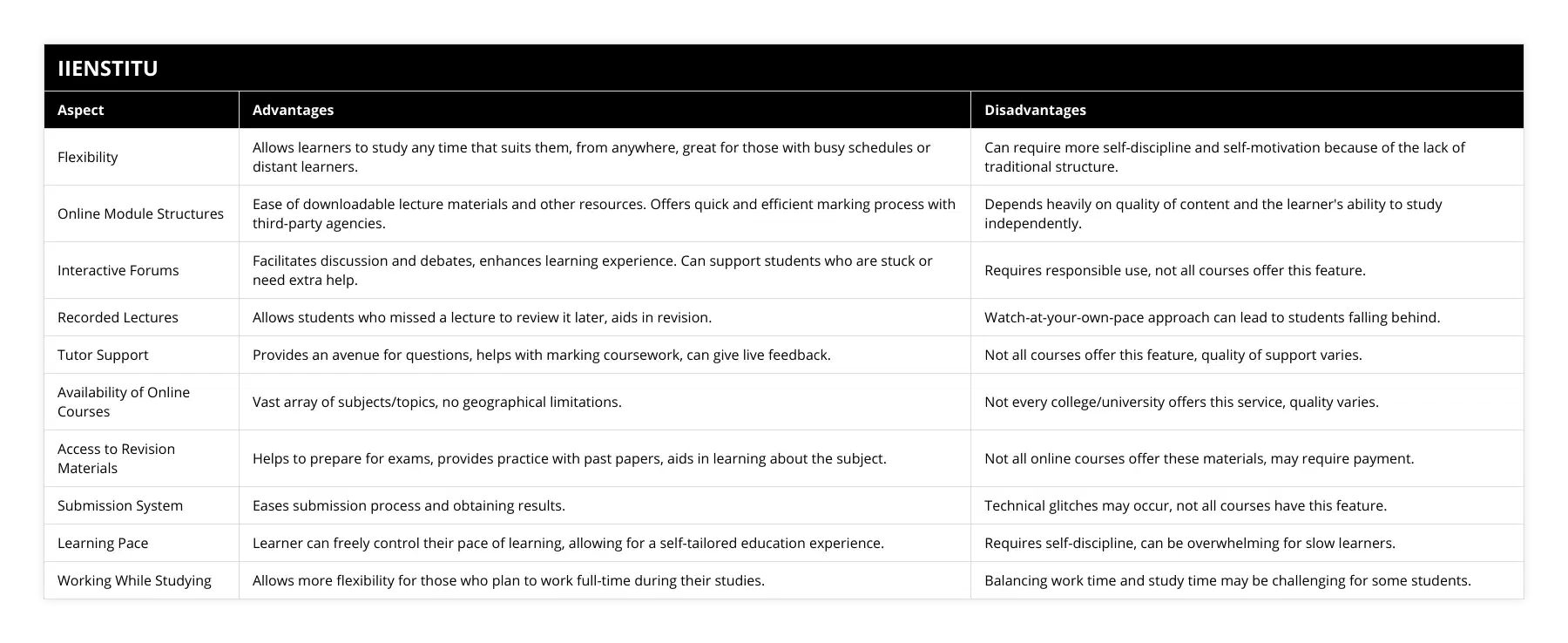
Frequently Asked Questions
What are the pros of online courses?
The pros of online courses are that you can learn interactively and engagingly. Many online courses use multimedia elements such as videos, audio recordings, and infographics to help students grasp new concepts. Plus, most online classes allow students to participate in discussion forums where they can share ideas and get feedback from their peers.
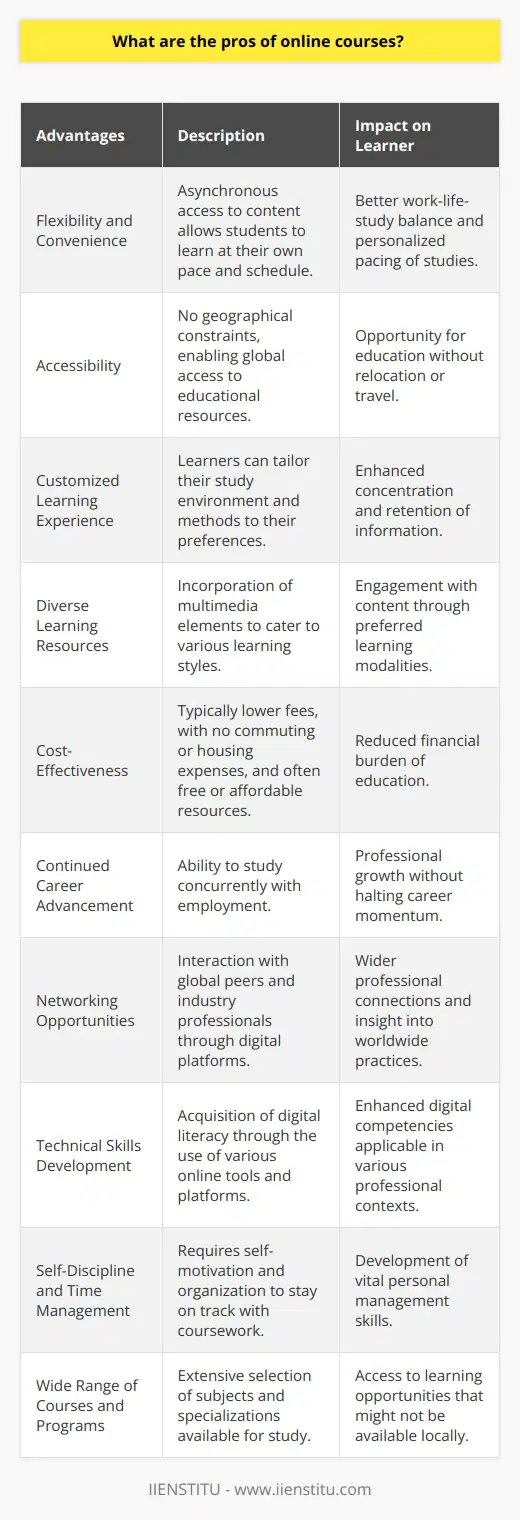
What are the cons of online courses?
They can be isolating, unengaging, and sometimes inconsistent in quality. So, you should ensure the quality.

Which are better online courses or traditional classes?
Online courses are better because we are in the technology age. Technology has made it possible for people to learn from anywhere. There is no need to be in a classroom physically. You can learn at your own pace and convenience. You can also get more out of an online course than in a traditional class because there is more interaction and engagement with the instructor and other students.

What are the primary benefits and drawbacks of virtual learning compared to traditional classroom settings?
Primary Benefits of Virtual Learning
Firstly, virtual learning fosters flexibility in scheduling, as students can access courses and materials anytime, anywhere, thereby accommodating various learning styles and time commitments. Additionally, online education often incorporates multimedia resources, such as videos and interactive slides, promoting student engagement and enhancing understanding of complex concepts. Furthermore, virtual platforms facilitate collaborative learning through discussion boards and group chats, enabling learners to exchange ideas and perspectives from diverse geographical locations. Lastly, virtual learning contributes to environmental sustainability by reducing paper consumption and lowering carbon emissions from commuting.
Drawbacks of Virtual Learning
However, virtual learning also presents several challenges. One of the primary concerns is the lack of social interaction, as students miss out on face-to-face communication and building relationships with peers and instructors. This lack of social engagement may lead to feelings of isolation and decreased motivation for some learners. Additionally, virtual learning requires a solid internet connection and reliable devices, which may not be accessible for all students, potentially exacerbating existing educational disparities. Furthermore, online learning environments can be vulnerable to distractions, such as social media and household interruptions, that may hinder overall productivity and focus. Finally, there exists the concern that the quality of education in virtual settings may not be equivalent to that of traditional classrooms, as some educational approaches, such as hands-on activities and experiential learning, are difficult to replicate in an online format.

How does online education impact the social aspects and interaction between students and teachers?
Impact on Social Aspects
Online education significantly influences the social aspects of learning by altering the interaction dynamics between students and teachers. The absence of a physical classroom necessitates the creation of a virtual environment that fosters communication, collaboration, and camaraderie. Traditional social cues, such as body language and facial expressions, are often lost in digital communication, raising the risk for misunderstanding and misinterpretation. Consequently, learners and educators alike need to adapt to new modes of communication, such as discussion boards, video calls, and instant messaging.
Digital Divide and Disparities
Another critical issue in online education is the digital divide, a term that reflects the inequalities in access to technology and the internet. While some students enjoy high-speed connectivity and advanced devices, others struggle with poor internet access and outdated equipment. This disparity not only affects the learning experience but can also impact students' ability to connect and interact with their peers and teachers. Schools and governments must recognize these challenges and devise strategies to minimize disparities and promote social inclusion.
The Role of Technology in Relationship Building
Technology plays a vital role in enhancing social interaction in online education. Platforms such as educational forums, group chats, video conferencing, and social media, when integrated thoughtfully, can help bridge the gap between students and teachers, fostering the meaningful relationships necessary for effective learning. While these digital tools cannot replace the face-to-face experience completely, they can help create a sense of community and belonging, encouraging students to forge connections more deep than anticipated with their instructors and peers.
Strategies to Foster Social Interaction
Students and teachers can adopt various strategies to establish meaningful connections in online education, such as:
Active Participation: Engaging in discussions, asking questions, and sharing thoughts encourages a sense of camaraderie and promotes interaction.
Establishing Norms: Creating rules and expectations for communication can help establish a safe and open environment for everyone.
Developing a Learning Community: Creating group projects or group activities can foster collaboration and teamwork among students.
Personal Connections: Encouraging sharing of personal experiences, interests, and hobbies can help humanize online interactions.
To conclude, online education has a profound impact on the social aspects of learning due to the altered nature of interaction between students and teachers. However, with thoughtful use of technology, awareness of digital disparities, and the implementation of effective strategies, it is possible to create a rich, social learning experience that fosters connection and engagement.
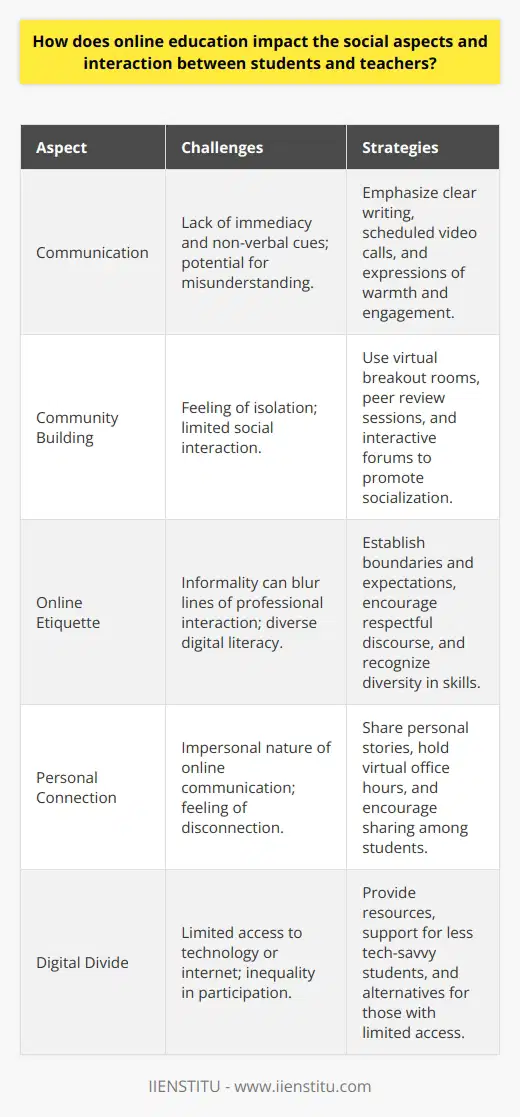
In what ways can online learning environments enhance or hinder the accessibility and inclusivity of education for diverse groups of students?
Enhancing Accessibility through Online Learning
Online learning environments can significantly enhance the accessibility and inclusivity of education for diverse groups of students. By overcoming physical barriers, this mode of education provides opportunities for students with mobility challenges or those living in remote areas. It allows them to participate in courses without the need for physical attendance in classrooms, which can be a significant advantage.
Flexible Scheduling for Varying Needs
Importantly, online learning offers flexible scheduling options that cater to the needs of students with differing commitments and requirements. Asynchronous learning techniques, such as recorded course materials, provide learners with the ability to access content at their convenience, accommodating work or family commitments. This flexibility encourages broader participation from various groups that typically face hurdles in traditional educational settings.
Tailoring Content for Diverse Learners
Digital learning platforms have the potential to provide tailored content that adapts to the specific needs of diverse learners. By employing adaptive learning methods, educators can adjust the presentation, pacing, and difficulty of material to suit individual student needs. This personalized approach can be particularly beneficial for those with learning disabilities or language barriers, making education more accessible and inclusive.
The Potential for Exacerbating Inequalities
However, it is crucial to recognize that online learning environments can also hinder accessibility and inclusivity in some cases. The reliance on digital technology may exacerbate existing socioeconomic disparities, as not all students have equal access to computers, stable internet connections, or other necessary resources. the lack of access to appropriate devices and connectivity may limit a student's ability to participate fully in online learning experiences.
The Importance of Human Interaction
Additionally, the nature of computer-mediated instruction may impede meaningful connections and interactions between students and educators, which play a critical role in fostering educational engagement and motivation. Some learners may require additional support or face-to-face contact with instructors to effectively navigate online learning environments. Thus, a nuanced understanding of the ways in which diverse student needs can be met in virtual settings is essential for achieving true accessibility and inclusivity in online education.
In conclusion, while online learning environments can enhance accessibility and inclusivity in education, these benefits are not experienced uniformly by all students. It is vital for educators to be aware of the challenges faced by diverse groups, ensuring that technology is used to support and engage all learners instead of inadvertently contributing to existing inequalities.
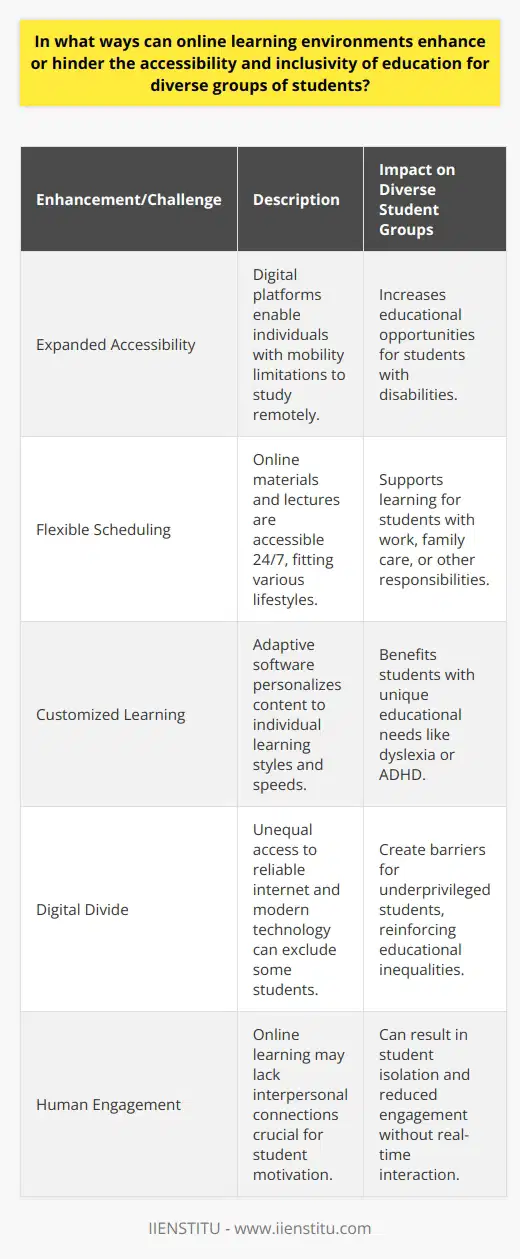
What is the relationship between student engagement and online learning outcomes?
Relationship Between Student Engagement and Online Learning Outcomes
Active Participation in Online Learning
Student engagement plays a crucial role in online learning outcomes, as it promotes active participation in the learning process. Online learners actively engage in various activities, such as discussions, group projects, and assignments, enabling them to gain a better understanding of the content and develop essential skills.
Motivation for Better Learning Outcomes
When students are engaged in their education, they are motivated to learn and eager to participate in activities. This motivation enhances their overall learning experience and leads to improved learning outcomes. Engaged students display a higher retention of material, better problem-solving skills, and improved critical thinking abilities.
Constructivism in Online Learning
In online learning environments, constructivist theories emphasize the importance of active student engagement in constructing knowledge through interaction with their peers, instructors, and course materials. This interactive engagement helps stimulate students' cognitive processes and facilitates the acquisition of new knowledge and understanding, ultimately leading to more favorable learning outcomes.
Technology Impact on Engagement
The use of modern and interactive technologies in online learning environments can significantly improve student engagement. Innovative tools, such as discussion boards, virtual classrooms, and multimedia resources, provide opportunities for students to interact with their peers and instructors actively. These interactions foster an engaging learning environment, promoting collaboration and enhancing the overall learning experience.
Personalized Learning Experience
Another benefit of online learning and increased student engagement is the ability to provide a personalized learning experience. By tailoring content to individual students' needs and preferred learning styles, educators can promote effective student engagement, leading to improved learning outcomes. Through scaffolding and differentiation, online platforms cater to diverse student abilities and interests, improving engagement and increasing academic success.
In conclusion, there is a strong correlation between student engagement and online learning outcomes. Actively engaged students are more motivated to learn, develop better problem-solving and critical thinking skills, and retain course material more effectively. The increase in personalized learning experiences and the use of interactive technology in online learning environments further supports the importance of student engagement and its impact on learning outcomes.
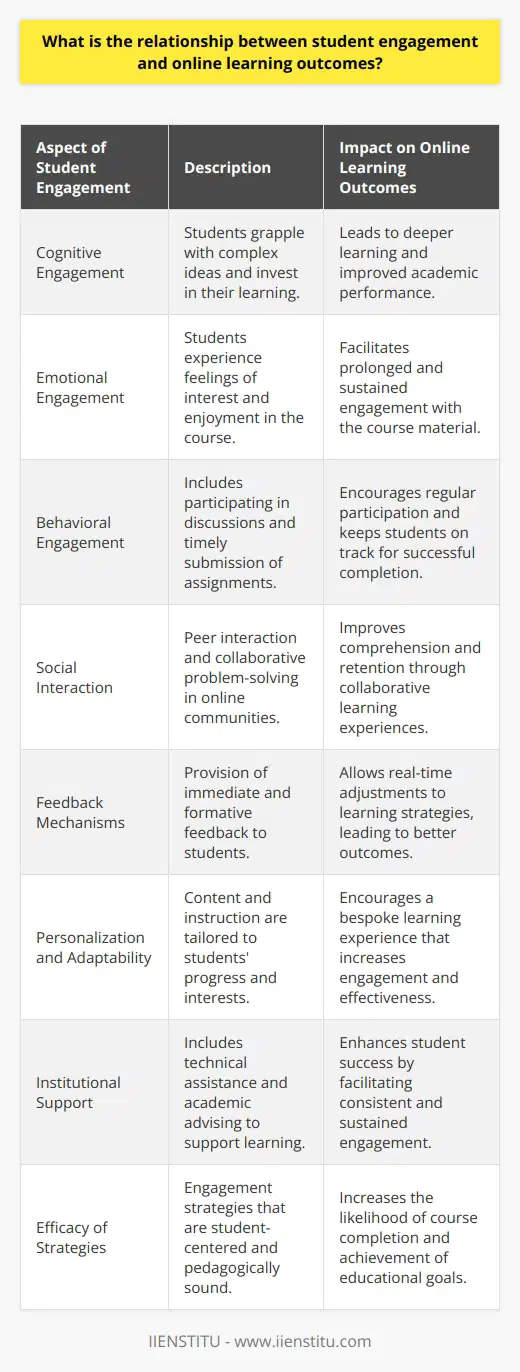
How do online platforms ensure academic integrity and fairness in assessments?
Promoting Academic Integrity through Technology
One central aspect of upholding academic integrity and fairness in online assessments is the utilization of technology. Various platforms offer unique tools and solutions to monitor, control, and ensure academic honesty during assessment processes. This answer discusses three essential factors, namely, plagiarism detection tools, online proctoring, and diverse assessment methodologies, that are critical to maintaining academic integrity in online assessments.
Plagiarism Detection Tools
A key component in fostering academic integrity in online assessments is the use of plagiarism detection software. This technology identifies instances of plagiarism by comparing submitted work against a vast database of academic sources, helping educators ensure originality and authenticity. With the help of such tools, online platforms significantly reduce instances of cheating and promote a fair evaluation process.
Online Proctoring Services
In recent years, online proctoring has become a standard procedure for ensuring academic integrity during online assessments. These services use real-time video monitoring and artificial intelligence to supervise assessments remotely. Through this method, examiners can detect and prevent unethical practices such as unauthorized collaboration, the use of cheat sheets or electronic devices, and impersonation. Online proctoring is thus vital in upholding academic integrity and creating a level playing field for all test-takers.
Diverse Assessment Methods
Lastly, implementing diverse assessment methods is crucial for enhancing academic integrity and fairness in online platforms. By utilizing various evaluation techniques, such as multiple-choice questions, essay assignments, peer assessments, and group projects, instructors can discourage cheating and encourage holistic learning. This array of assessment methods provides opportunities for students to demonstrate their understanding of the material and strengthens the validity of the evaluative processes.
In conclusion, online platforms utilize a combination of plagiarism detection tools, online proctoring, and diverse assessment methods to ensure academic integrity and fairness. The advancement of technology has allowed these platforms to create a secure and ethical environment for learning and evaluation, fostering a culture of honesty and academic growth.
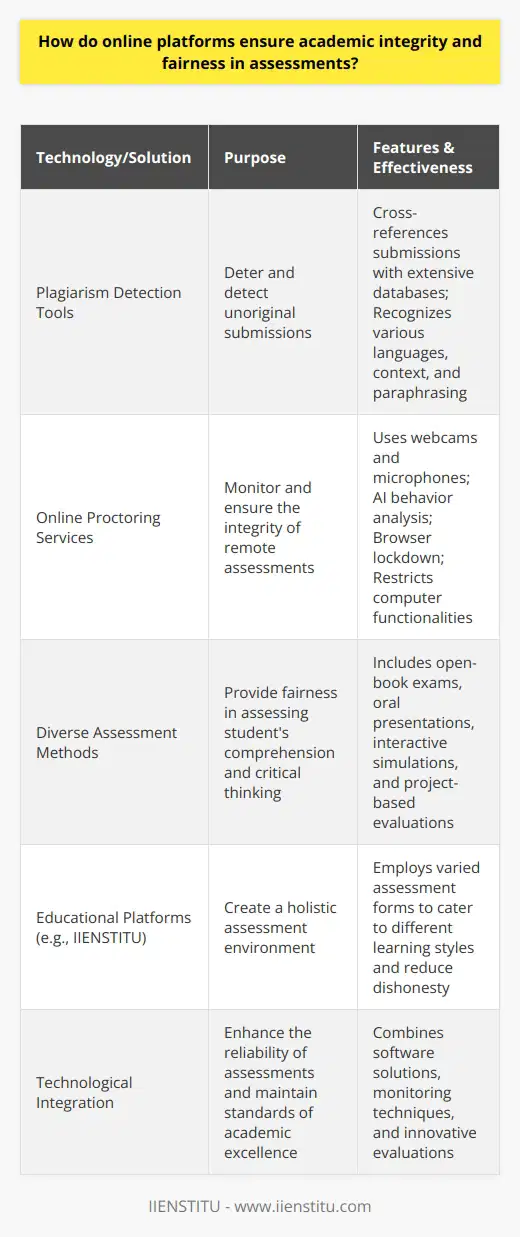
To what extent do online learning environments impact mental health and well-being?
Online Learning Environments and Mental Health Impacts
Online learning environments have become increasingly prevalent, especially during the COVID-19 pandemic. These environments, while providing an accessible mode of obtaining education, have created concerns around impacts on mental health and well-being.
Benefits of Online Learning
There are several positive aspects of online learning that can contribute to improved mental health. For instance, the flexibility and convenience offered by online platforms can help reduce stress and anxiety associated with traditional learning schedules. Furthermore, learners can access course materials at their own pace, which may cater better to individual needs and preferences.
Challenges Linked to Online Learning
Despite these benefits, online learning environments also pose potential issues for mental health and well-being. One of the most significant concerns is the lack of social interaction, which can lead to feelings of isolation and loneliness. The absence of face-to-face communication with peers and instructors can also make it more difficult for students to build essential social connections and develop communication skills.
Screen time and sedentary lifestyles are other detrimental factors. Sitting for extended periods can contribute to physical health problems, which in turn can affect mental well-being. Additionally, increased screen time from online learning can lead to eye strain and disrupted sleep patterns, further impacting mental health.
Cyberbullying and Mental Health
Another critical concern is cyberbullying, which can occur in online learning environments. Cyberbullying may involve ridicule, harassment, or humiliation in online settings, and it may have severe consequences for the victim's mental health. Research has shown that victims of cyberbullying may experience increased levels of stress, anxiety, and depression.
Supporting Mental Health in Online Learning
To counter these challenges and support mental health, it is crucial to incorporate measures that foster connectedness and well-being in online learning environments. This can include establishing online social spaces, encouraging students to participate in group activities, and offering regular feedback and support from instructors.
Moreover, developing healthy habits such as taking breaks from screens, incorporating physical activity, and implementing self-care strategies can help to relieve stress and maintain mental well-being.
Conclusion
In conclusion, online learning environments do impact mental health and well-being to a certain extent. While they offer some benefits, the challenges of social isolation, sedentary lifestyles and increased screen time, and cyberbullying also pose risks. Implementing supportive strategies can help mitigate these issues and foster a more balanced approach to online learning.

What are the key factors that contribute to the effectiveness of online learning compared to in-person classes?
Flexible Learning Environment
A crucial factor contributing to the effectiveness of online learning is the availability of a flexible learning environment. Learners can access materials, engage in discussions, and complete assignments at their own pace, benefitting from the convenience and adaptability that online platforms offer. This flexibility allows students to pursue their education while managing jobs and personal responsibilities, thus expanding educational opportunities for diverse populations.
Interaction and Collaboration
Online learning environments also facilitate interaction and collaboration between learners and instructors, providing numerous opportunities for discussion, feedback, and knowledge sharing. With a range of digital tools easily accessible, such as forums, messaging platforms, and video conferences, online learning encourages continuous communication and promotes a sense of community within the class. This interactive environment can ultimately boost students' motivation, self-efficacy, and overall satisfaction, contributing to their academic success.
Diverse Teaching Methods
In contrast to traditional in-person classes, which may be limited by location, time, and resources, online learning can employ a myriad of digital tools and platforms that facilitate various teaching methods. These include multimedia presentations, simulations, quizzes, and gamification strategies, enabling students with different learning styles to benefit from varied and engaging instruction. This integration of diverse teaching methods can lead to a more inclusive and effective learning experience for all students.
Instant Access to Information
Another key factor contributing to the effectiveness of online learning is the ease of instant access to information, which significantly expands the scope of educational resources. Online students have the opportunity to learn from multiple sources, including academic articles, multimedia materials, and external websites, without being limited by library hours or physical location. This access encourages an independent and exploratory approach to learning, fostering the development of critical thinking, research, and problem-solving skills.
Personalized Learning Pathways
Finally, online learning platforms often enable the development of personalized learning pathways for students, allowing them to customize their educational experience based on their individual needs and goals. Adaptive learning technologies can analyze students' performance and adjust the content, pace, and sequencing of instruction to address their unique strengths and weaknesses. This tailored approach to learning can not only increase students' motivation and engagement but also improve their academic outcomes.
In conclusion, the effectiveness of online learning compared to in-person classes can be attributed to a multitude of factors, including flexible learning environments, enhanced interaction and collaboration, diverse teaching methods, instant access to information, and personalized learning pathways. These elements collectively contribute to a more inclusive, engaging, and adaptable form of education, which ultimately aids in students' academic success.
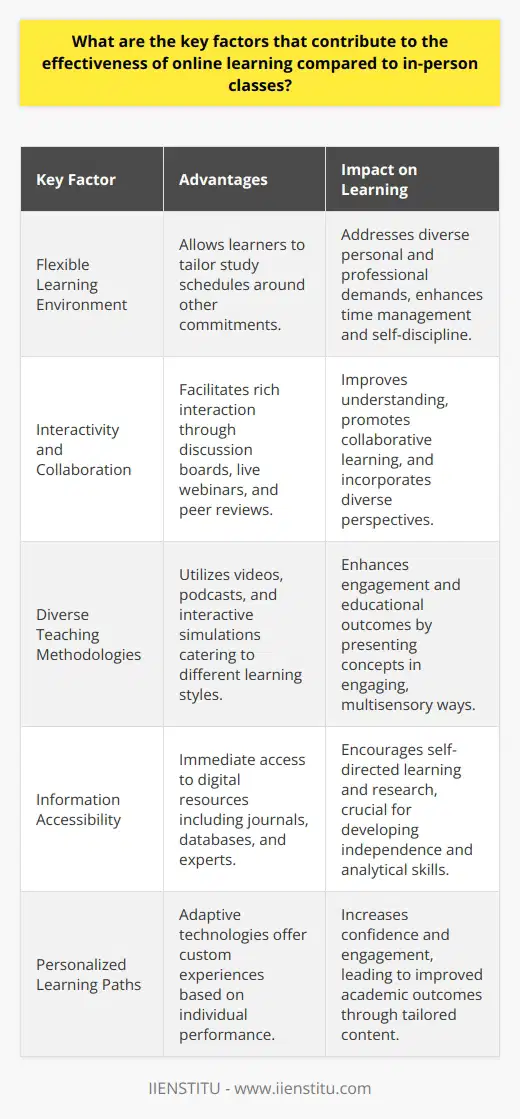
How do online learning platforms address the potential barriers and challenges faced by students with disabilities or limited socioeconomic resources?
Accessibility Features for Students with Disabilities
Online learning platforms actively address the barriers and challenges faced by students with disabilities through various built-in accessibility features. These features include text-to-speech options, closed captioning for video content, and screen readers for visually impaired learners, allowing them to access information with ease. Platforms also support adjustable font sizes and high-contrast displays, ensuring all learners feel comfortable and confident engaging with the content.
Inclusive Design and Universal Learning Principles
To cater to students with diverse needs and abilities, many online platforms adapt inclusive design and emphasize universal learning principles. By offering multiple means of representation, engagement, and expression, students have the flexibility to choose accessible formats that suit their individual learning styles and preferences. Inclusive design ultimately benefits all learners, not just those with disabilities, as it fosters a more diverse and equitable learning environment.
Supporting Students with Limited Socioeconomic Resources
Equitable access to education is a concern for students with limited socioeconomic resources. Online learning platforms address this issue by offering affordable and, in some cases, free access to courses and educational content. Furthermore, these platforms often provide mobile accessibility, allowing students to access their courses from their smartphones, tablets, or any internet-connected device. This flexibility in access points reduces the digital divide, allowing students with limited resources to pursue their education without incurring unnecessary expenses.
Scholarships and Financial Aid
To further support students with limited socioeconomic resources, many online learning platforms offer scholarships and financial aid. These grants and tuition assistance programs ensure that learners can access quality education despite their financial constraints. This investment in the education of students from marginalized backgrounds can significantly impact their personal and professional development prospects.
Collaboration with Non-Profit Organizations
Online learning platforms also collaborate with non-profit organizations, educational institutions, and government agencies to provide targeted support and resources to students with disabilities and limited socioeconomic resources. Partnerships with these organizations can bolster the provision of specialized support services, such as assistive technologies, mentorship, and academic accommodations. This collaborative approach contributes to the creation of inclusive and supportive online learning spaces that cater to diverse student needs.
In conclusion, online learning platforms actively address the barriers and challenges faced by students with disabilities or limited socioeconomic resources through a combination of accessibility features, inclusive design principles, affordability, scholarships, and strategic partnerships. This commitment to equity and inclusion in online education ensures that all learners have the opportunity to access quality education and reach their full potential.
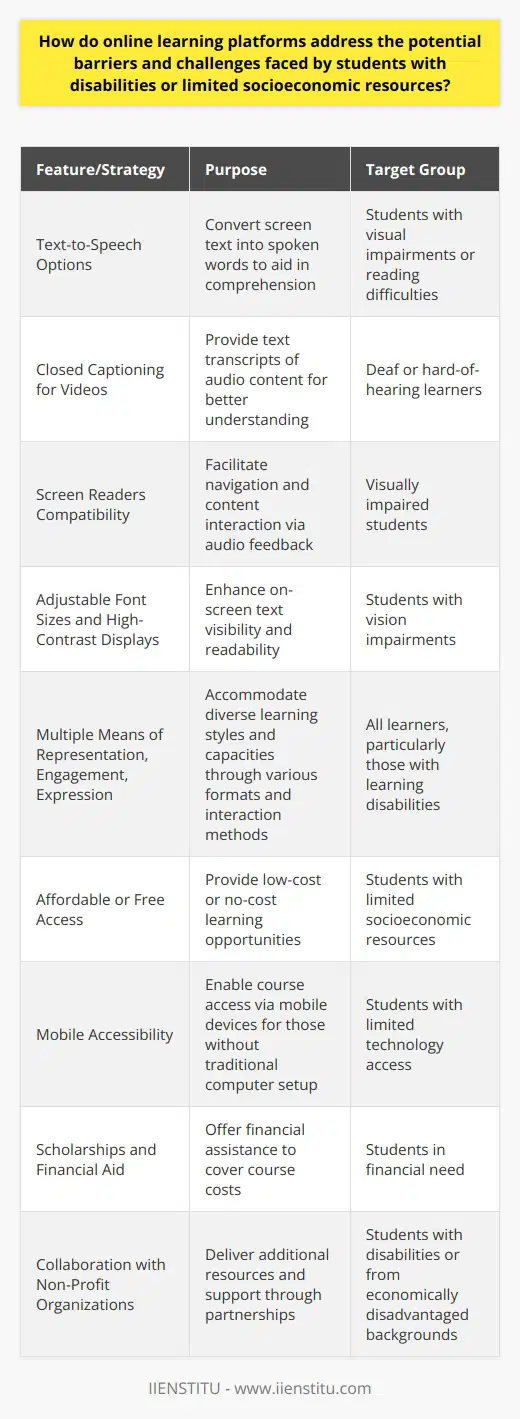
In what ways can the design and implementation of online courses be improved to better support personalized learning and individual student needs?
Enhancing Course Flexibility
To better support personalized learning and individual student needs, online courses can improve their design and implementation in several ways. First, enhancing course flexibility is crucial for accommodating diverse learning styles and schedules. This can be achieved by offering various course formats, such as self-paced learning, instructor-led sessions, or a combination of both. By providing students with choices, they can select the learning model that suits them best, leading to a more personalized experience.
Incorporating Multimedia Elements
Another approach involves incorporating multimedia elements, including video lectures, audio recordings, and interactive simulations. These diverse resources cater to different learning preferences, ensuring that students can choose how they wish to engage with the course material. For instance, visual learners may prefer watching video lectures, whereas auditory learners can benefit from listening to audio recordings. Moreover, interactive simulations can provide valuable hands-on experience for students who learn best through practical application.
Facilitating Individual Feedback and Support
Online courses can also improve individual student support through the implementation of regular, personalized feedback. Instructors can provide students with individualized assessments, highlighting areas of progress and suggesting specific areas for improvement. This targeted feedback allows students to focus their efforts effectively, leading to an enhanced learning experience. Additionally, offering personalized support structures, such as one-on-one tutoring sessions or small group discussions, can further cater to individual learning needs.
Increasing Opportunities for Collaboration
Fostering collaboration within online courses is another way to support individualized learning. Offering tools for real-time communication, such as chat groups or virtual meetings, can facilitate peer interaction and help students learn from each other's diverse perspectives. Instructors can also create collaborative assignments or group projects that give students the opportunity to discuss ideas, solve problems, and share resources. By actively engaging with peers, students can benefit from personalized feedback and targeted guidance based on their individual needs.
Constantly Updating Course Material
Lastly, to ensure that online courses remain relevant and appropriate for students' needs, instructors should update course content regularly. By soliciting feedback from students and revising materials accordingly, instructors can ensure that their courses continue to address individual learning needs effectively. This iterative process fosters a dynamic learning environment, where students feel that their input is valued and can actively shape their educational experience.
By incorporating these strategies, online courses can better support personalized learning and cater to individual student needs, ultimately promoting a more engaging and effective educational experience.
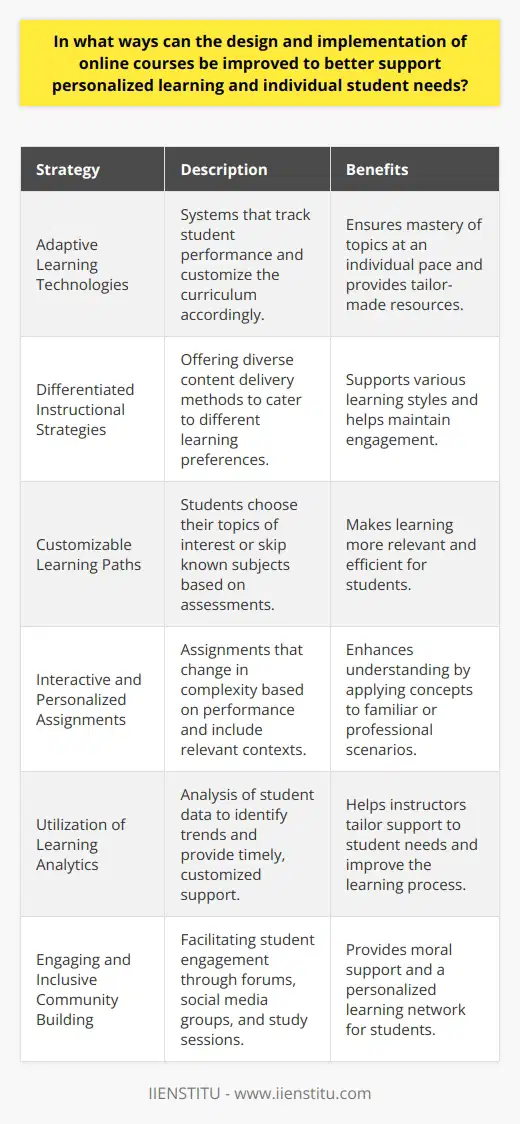
What are the advantages of online learning in fostering collaboration and communication among students from diverse backgrounds?
Fostering Collaboration in Online Learning
One advantage of online learning lies in its potential to facilitate collaboration between students from diverse backgrounds. Through virtual platforms, learners can easily engage with their peers from different cultures, ethnicities, and socioeconomic statuses, thereby promoting inclusion and understanding. This diversity fosters the exchange of varied perspectives, enriching discussions and group projects in the digital learning environment.
Leveraging Technological Tools
Online learning platforms offer a range of technological tools that support and encourage collaborative learning. Asynchronous discussion forums and real-time video conferencing enable students to work together, regardless of their geographic location, and effectively communicate their ideas. Additionally, cloud-based resources such as Google Docs allow for collaborative document editing, streamlining group work and enhancing cooperation among peers with different learning styles and approaches.
Enhancing Communication Skills
The online learning environment also helps develop critical communication skills among students, including written, oral, and nonverbal methods. This helps establish respect and understanding among participants from diverse backgrounds, as they learn to express their thoughts and opinions coherently and respectfully, and are exposed to alternative perspectives. Digital platforms cultivate a space for active listening and constructive feedback, essential elements for inclusive communication and teamwork.
Building Cultural Awareness
Interacting with students from varied cultural backgrounds can enhance one's cultural awareness and sensitivity. Online learning encourages learners to appreciate and embrace differences, fostering an inclusive environment where all individuals can thrive. Consequently, these experiences contribute to the development of a global mindset and prepare students for effective collaboration in the diverse workplaces of today.
Promoting Access and Equity
Lastly, online learning supports greater access and equity by providing opportunities for participation in education for those who might otherwise face barriers, such as distance, disability, or socio-economic factors. This inclusivity opens doors for collaboration among individuals from diverse cultures and circumstances that may have been previously inaccessible, providing a well-rounded educational experience and promoting the value of diversity and inclusion.
In conclusion, online learning serves as an effective method for fostering collaboration and communication among students from diverse backgrounds. Through digital platforms, technological tools, and exposure to varied perspectives, learners develop critical communication skills, cultural awareness, and a global mindset that prepares them for success in our interconnected world.

How do online class structures affect the development of critical thinking and problem-solving skills compared to in-person classes?
Effect on Critical Thinking
The development of critical thinking skills is a crucial aspect of education, and it is important to consider the impact of online class structures on this process. Compared to in-person classes, online classes often lack the immediate and continuous feedback offered by face-to-face interactions. As a result, students might experience difficulties in recognizing and rectifying misconceptions, which could hinder the development of their critical thinking abilities.
Role of Technology in Problem-Solving Skills
In contrast, online classes utilize various technological tools that can actively contribute to the development of problem-solving skills. For instance, students can access a wide range of resources, such as video lectures, interactive quizzes, and discussion forums. These tools often provide immediate feedback, allowing learners to identify their mistakes, reflect on their problem-solving process, and refine their strategies accordingly. Furthermore, online classes often require students to actively navigate and engage with digital tools, further enhancing their problem-solving abilities in a technology-driven context.
Importance of Collaborative Learning
Another essential factor to consider is the role of collaborative learning in fostering critical thinking and problem-solving skills. While in-person classes frequently incorporate group discussions and collaborative activities, online classes might not offer these opportunities as readily. However, the implementation of virtual discussion boards, group projects, and video conferencing can overcome such limitations. By engaging in collaborative learning experiences, students can exchange ideas, challenge one another's perspectives, and develop the capacity to critically analyze and solve complex problems.
Instructor's Role and Pedagogical Strategies
The role of the instructor and the pedagogical approach employed in online classes is also a significant factor in determining the effectiveness of developing critical thinking and problem-solving skills. Just as in-person classes, online courses must be thoughtfully designed to promote active learning, critical reflection, and continuous feedback. By adopting pedagogical strategies that prioritize student-centered learning, the instructor can facilitate the development of these essential skills in the online setting.
In conclusion, while online class structures may present some unique challenges to the development of critical thinking and problem-solving skills compared to in-person classes, these challenges can be adequately addressed through the integration of interactive digital resources, collaborative learning experiences, and effective pedagogical strategies. By leveraging such tools and approaches, online educators can successfully cultivate these skills in their students, bridging the gap between the virtual and the physical classroom.
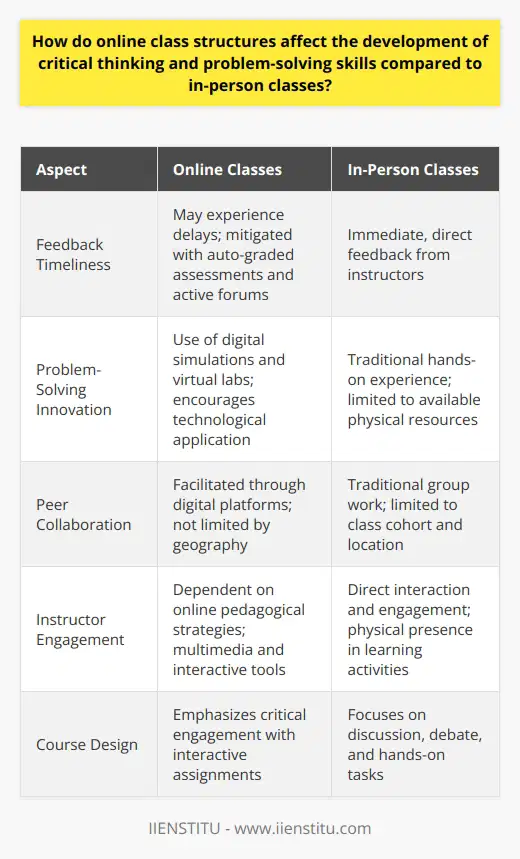
What strategies can be employed to bridge the gap between online and in-person learning experiences to optimize student success and satisfaction?
Integrating Hybrid Learning Models
To optimize student success and satisfaction, integrating hybrid learning models that combine online and in-person learning experiences can be employed. In this approach, educators need to carefully strategize the best course of action for their students.
Leveraging Technology
One key strategy is leveraging technology in course delivery. For instance, using video conferences and online discussion boards allow students to interact with their instructors and peers easily. Additionally, incorporating e-learning platforms and digital resources, such as multimedia content or interactive quizzes, helps keep students engaged, ensuring a seamless learning experience that rivals the benefits of face-to-face interactions.
Emphasizing Communication
Efficient communication is crucial in bridging the gap between online and in-person learning experiences. Synchronous communication tools, such as live chats or video calls, facilitate real-time responses and allow students to discuss course material, clarify doubts, and get instant feedback from instructors. Asynchronous communication, such as email and discussion forums, complements synchronous interactions by letting students and educators address queries and share ideas at their own pace.
Providing Personalized Support
To optimize student satisfaction, providing personalized support tailored to each student's unique learning needs should be prioritized. This approach may encompass creating individualized learning plans, offering one-on-one mentoring sessions, or setting up virtual office hours. By catering to different learning styles and preferences, students can gain a more comprehensive understanding of course materials, ultimately leading to enhanced satisfaction and success rates.
Fostering a Community
Creating a sense of community among students, both online and offline, is integral to bridging the gap between online and in-person learning experiences. Encouraging group projects or informal meet-ups, where students can collaborate and learn from each other, can result in a more engaging and supportive learning environment. Moreover, utilizing social media platforms for announcements, updates, and discussions ensures a cohesive and informed student community.
Assessing and Adapting
Finally, consistently assessing the effectiveness of implemented strategies and being open to adapting them when necessary is essential. This may involve gathering feedback from students regarding their experiences, studying learning outcomes, or utilizing data analytics tools to assess student engagement and performance. Informed decision-making based on evidence allows continual refinement and improvement of the chosen strategies, ensuring an optimal blend of online and in-person learning experiences.
Overall, a combination of hybrid learning models, leveraging technology, efficient communication, personalized support, fostering a sense of community, and consistent assessment are crucial strategies to bridge the gap between online and in-person learning experiences, ensuring optimized student success and satisfaction.
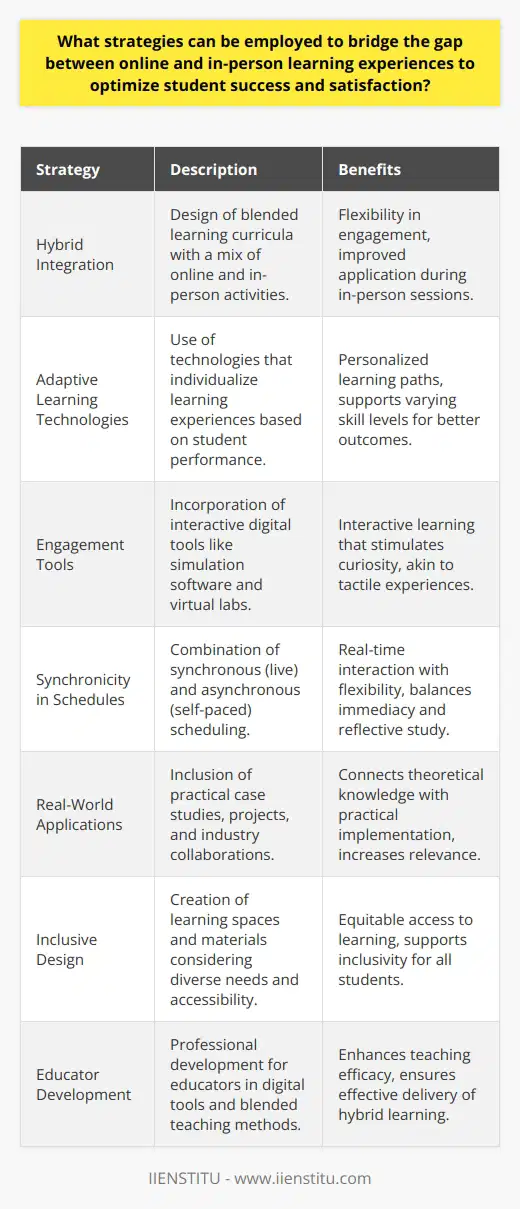
What are the pros of online learning?
Advantages of Online Learning
Flexibility in Scheduling
Online learning provides students with the flexibility to manage their time more effectively. They can choose when to study, fitting their education around work, family, and personal commitments. This accessibility enables individuals to pursue their educational goals without compromising other responsibilities, such as job or family.
Accessibility and Inclusivity
Another advantage is that it allows learners from various backgrounds, locations, and abilities to access educational materials. This inclusive nature accommodates those who previously faced geographical or financial barriers to attending traditional institutions. Moreover, online platforms often offer assistive technologies and inclusive design, supporting learners with disabilities or impairments.
Variety of Learning Resources
Online courses often utilize a wide array of learning resources, including multimedia presentations, interactive quizzes, and discussion forums. This assortment of materials caters to diverse learning styles, allowing students to engage with content in ways that suit them best. Consequently, online learning can be more effective and enjoyable than traditional classroom settings.
Cost Effectiveness
Another pro of online learning is its cost-effectiveness. Tuition fees for online courses are typically lower than those for on-campus programs, so students can save on education costs. Furthermore, distance learning eliminates expenses such as commuting, housing, and meals that are often associated with attending traditional institutions. Hence, it makes education more affordable for a larger number of people.
Networking Opportunities
Online learning platforms frequently prioritize interaction and collaboration, enabling learners to connect with peers and experts from around the world. This global networking exposes students to new perspectives, fosters collaboration across cultures, and can even lead to professional connections and opportunities.
Personalization of Learning
Finally, online courses often provide individualized learning paths, allowing students to progress at their own pace and focus on areas of personal interest. This personalization enables learners to tailor their education to their unique needs and goals, leading to a more engaging and productive learning experience.
In conclusion, the pros of online learning stem from its accessibility, inclusivity, flexibility, cost-effectiveness, and personalization. By providing unique opportunities and advantages over traditional classroom settings, online learning supports a diverse range of learners in achieving their educational objectives.
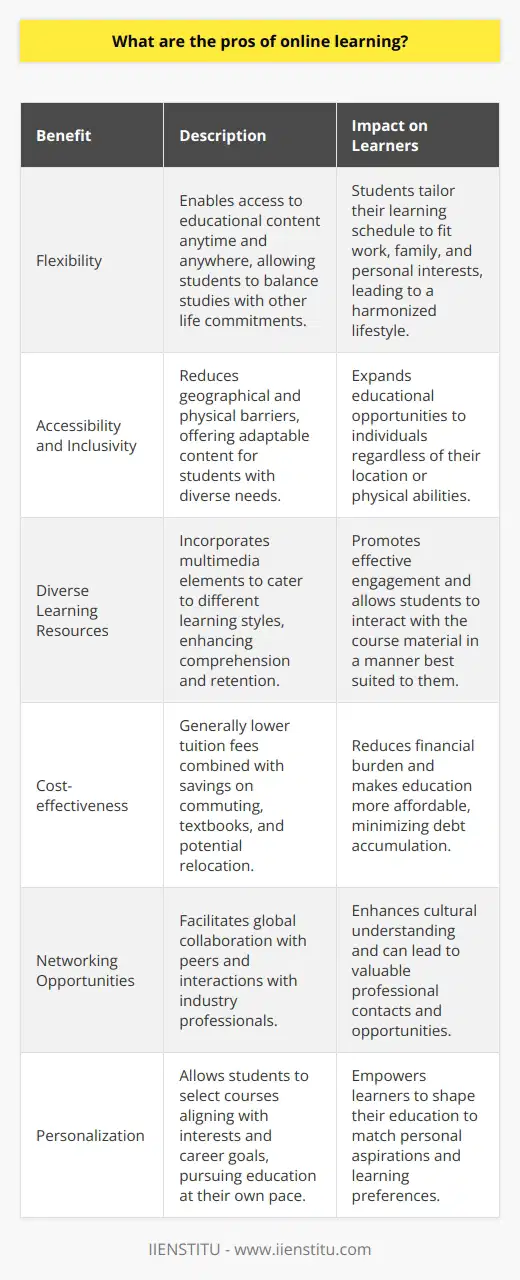
What are the 5 disadvantages of online classes?
Inadequate Interaction and Communication
One of the significant disadvantages of online classes is the lack of adequate interaction and communication between students and their instructors. This negatively affects the learning experience as it is hindered by a limited face-to-face connection and insufficient opportunities for in-person discussions or clarifications.
Technological Issues
Another disadvantage of online classes is the potential for technological issues. Students may experience difficulties in accessing course materials, connecting to live sessions, or submitting assignments due to unreliable internet connectivity, software problems, or incompatible devices. These issues could cause frustration and delays in completing coursework.
Limited Access to Resources
Online classes often provide limited access to resources compared to traditional in-person classes. Students may not have the same access to library materials, lab facilities, or learning support services which can affect their educational experience and academic performance.
Less Motivation and Engagement
A lack of motivation and engagement is also a significant concern for online classes. Students may struggle to stay focused and actively participate in discussions or group projects, causing a decline in overall interest and investment in their education. Furthermore, the absence of a structured learning environment can make it difficult for students to develop and maintain effective study habits.
Difficulty in Assessing Learning Outcomes
Lastly, assessing learning outcomes can be challenging for instructors in online classes. It becomes difficult to ensure the academic integrity and assess the true understanding of concepts by students. Traditional assessment methods like exams and assignments do not always work effectively in an online environment, resulting in compromised evaluation and feedback processes.
In conclusion, despite offering flexibility and convenience, online classes come with disadvantages that can impact students' learning experiences. The challenges in communication, technological issues, limited access to resources, lack of motivation, and difficulty in assessing learning outcomes serve as potential obstacles in obtaining a high-quality education through online platforms.
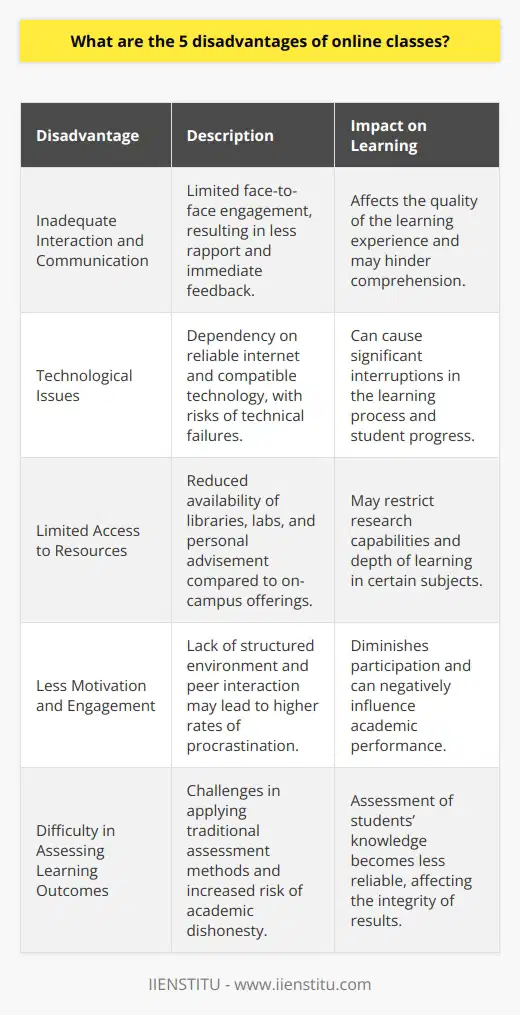
What are the disadvantages of online courses?
Inadequate Interaction
One of the major disadvantages of online courses is the inadequate interaction between students and instructors. While online platforms offer numerous communication tools such as discussion boards, emails, and video conferences, these cannot fully compensate for the richness of face-to-face communication. As a result, students may experience difficulty receiving timely feedback, asking questions, and engaging in meaningful debates, which may hinder their learning experience.
Technological Challenges
Another significant drawback of online courses is the dependence on technology. While many students today are well-versed with the digital world, some may still face challenges accessing or navigating online course materials. In addition, both students and instructors could face technical issues such as slow internet connections, outdated software, or malfunctioning devices, which may disrupt the learning process and lead to frustration.
Self-motivation
Furthermore, online courses may not be suitable for all individuals, since they often require strong self-discipline and motivation. Without the structure and regular schedule provided by traditional classroom settings, some students may struggle to manage their time effectively and consistently engage with the course material. Moreover, the absence of in-person support and the risk of isolation can make it difficult for some individuals to stay motivated throughout the course.
Academic Dishonesty
Finally, the potential for academic dishonesty in online courses is also a disadvantage. Without face-to-face instruction, it may be challenging for instructors to monitor student behavior, making it easier for students to cooperate on assignments, plagiarize work, or cheat on exams. Consequently, this poses issues related to academic integrity and credibility, potentially undermining the overall quality of online courses.
In conclusion, while online courses have become increasingly popular and provide numerous advantages, they also come with their own set of disadvantages. Issues related to interaction, technology challenges, self-motivation, and academic dishonesty can impact the effectiveness and credibility of online education. Therefore, it is crucial for educational institutions to take these concerns into account when designing and implementing online courses.
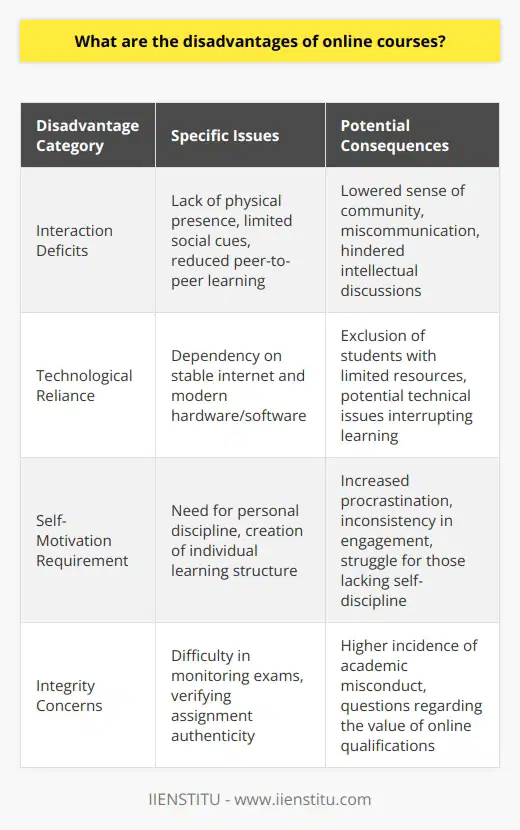
Are online courses effective in enhancing knowledge retention and skill development?
Effectiveness of Online Courses
Many question the effectiveness of online courses in enhancing knowledge retention and skill development. Research suggests that online courses can be as effective as traditional in-person learning.
In terms of Knowledge Retention
Studies show that online courses can potentially improve knowledge retention. Multimedia resources, like videos and animations, contribute to better memory recall. Immediate feedback given in the form of quizzes and interactive exercises enhances understanding. Learners can revisit online content, reinforcing the material which aids in memory retention.
Contribution Towards Skill Development
Online courses play a crucial role in skill development as well. Skill-based courses often include practical exercises. These simulations provide a real-world context leading to improved practical knowledge. Additionally, online courses emphasize self-discipline and time management. These indirect skills can transfer to other areas of a learner's life.
Effect on Learning Pace
Online courses allow individuals to learn at their own pace. This personalized pace accommodates different learning styles, which can lead to better comprehension of the material. It also reduces pressure associated with rigorous classroom scheduling.
Digitally Enhanced Collaboration
Collaboration is a key aspect of learning. Online courses facilitate global interaction and encourage diverse perspectives. Group projects and discussion forums foster interpersonal and team-work skills.
Conclusion
Online courses, therefore, offer an effective alternative for knowledge acquisition and skill development. Their effectiveness isn't inferior to traditional classroom-based learning. Personalized learning pace, digital collaboration, and the ability to revisit material contribute to this effectiveness. Despite some challenges, with proper planning and implementation, online learning can yield fruitful results.
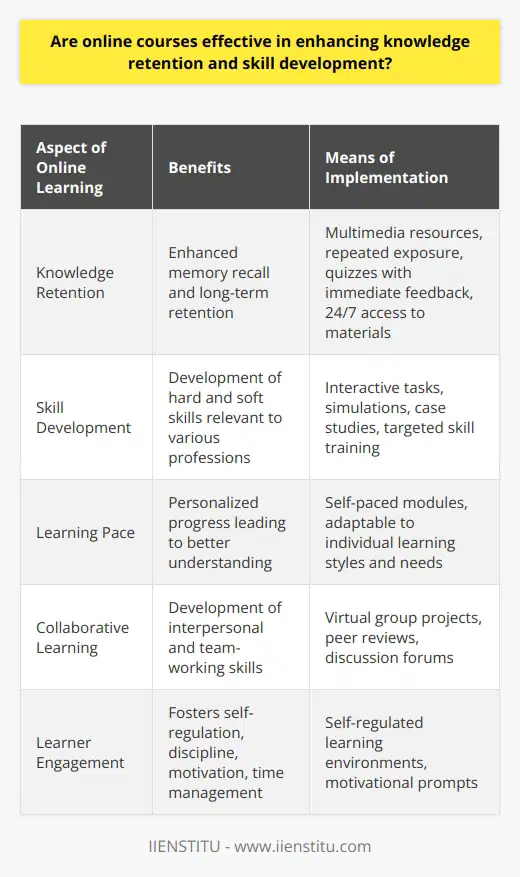
What are the primary factors that influence student motivation and self-discipline in online learning environments?
Personal Discipline and Autonomy
A principal factor is personal discipline and autonomy. It refers to a student's ability to self-motivate and manage study time independently.
Individual Learning Preferences
Individual learning preferences strongly influence motivation. Visual learners may struggle with text-heavy content, whereas auditory learners might find video lectures more engaging.
Course Design and Presentation
The design and presentation of the course influence motivation and discipline. Engaging, interactive and user-friendly courses stimulate interest and participation.
Access to Support Resources
Support resources such as clarification opportunities, feedback, and technical help enhance students' motivation. Feelings of support can foster perseverance.
Goal Setting and Achievement
Goal setting and achievement also impact motivation. Clear, achievable milestones encourage students to keep working, building discipline through repeated success.
Intrinsic Motivation
Intrinsic motivation – driven by personal interest or enjoyment in the work – plays a significant role. Engaging content that sparks interest enhances this type of motivation.
Extrinsic Motivation
Extrinsic motivation, stimulated by external incentives like grades or recognition, also plays its part. Recognition of effort and achievement motivates learners to strive for better performance.
Peer Interaction
Peer interaction provides an environment for collaborative learning and exchange of ideas, bolstering student motivation.
Online Learning Flexibility
Finally, the flexibility of online learning to fit around other life commitments can influence motivation and discipline. However, this flexibility demands strong time management skills.
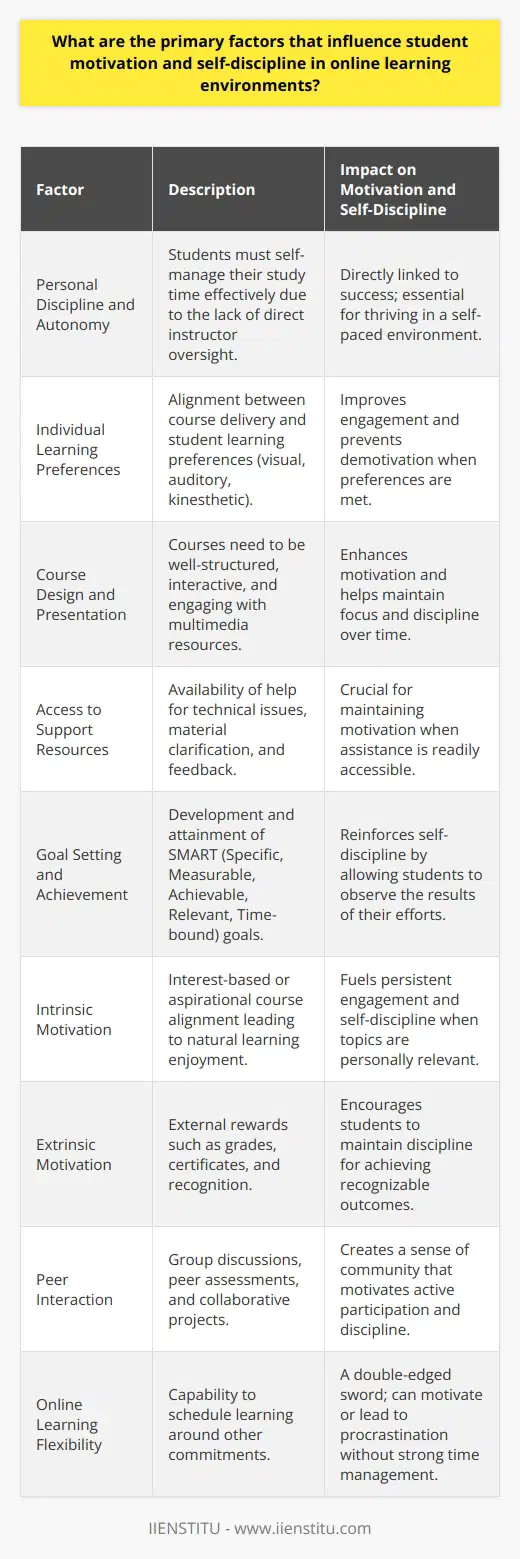
How can instructional design principles be adapted to optimize student engagement and learning outcomes in online courses?
Adapting Design for Student Engagement
Instructional design principles can improve engagement and outcomes in online courses. The first key is interactivity. Online learning requires engagement beyond simple reading. Teachers should incorporate multimedia content. This includes videos, images, and interactive quizzes.
Examining Learner Preferences
Understand learners' preferences. Some prefer visual materials while others prefer audio. Offering course materials in different formats can cater to these needs. This tailors the learning experience, increasing engagement and comprehension.
Enhancing Accessibility
Ensure online course material is accessible. Screen readers should easily navigate it. Additionally, content should be adaptable for those with color blindness or other visual impairments. When students can access content easily, they are more likely to engage.
Including Formative Assessments
Include formative assessments in the learning designs. Make them low-stakes and frequent. This approach allows real-time student progress tracking. Frequent assessments can trigger adjustments to the teaching methods in response.
Boosting Engagement with Collaboration
Format courses to enable collaboration between students. Peer interaction holds a pivotal role in effective learning. Discussion forums, group projects, and collaborative tools can facilitate this.
Anchoring Learning Through Real World Applications
Content should not only be theoretical. Always relate it to real-world applications. Explaining how knowledge applies outside the classroom boosts students’ understanding.
Conclusion
In conclusion, adapting instructional design principles like interactivity, diversified content, accessibility, formative assessments, collaboration, and real-world applications can optimize students' engagement and learning outcomes in online courses.
